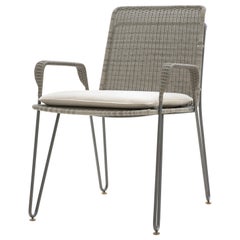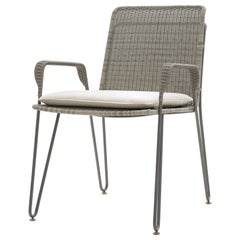Modern Outdoor Pelican Chairs
Recent Sales
21st Century and Contemporary American Modern Dining Room Chairs
Canvas
21st Century and Contemporary American Modern Dining Room Chairs
Canvas
21st Century and Contemporary American Modern Dining Room Chairs
Canvas
21st Century and Contemporary American Modern Dining Room Chairs
Canvas
HOLLY HUNT for sale on 1stDibs
The success of Holly Hunt — both the designer and her eponymous empire of textile and furnishings showrooms — is based on instinct.
The Chicago-based Hunt trusts her own tastes, reflected in her signature lines of elegant, low-key furniture, lighting and fabrics. She also trusts her judgment about the wants of the buying public, and this savvy sensibility has allowed her to cultivate and market the work of a range of contemporary talents, from minimalists like Christian Liaigre to eccentrics like Christian Astuguevieille.
Hunt is a design world impresario — a prominent arbiter for stylish modern interiors and known foremost for fabrics, seating designs and light fixtures. Modern sophistication, attention to detail, and a desire to cultivate talented contemporary designers are at the crux of the company’s success.
Born in central Texas to schoolteacher parents, Hunt was a creative girl who made her own clothes and bickered with her mother about decor. After graduating from Texas Tech, Hunt worked as department-store buyer and costume jewelry designer before marrying and helping her husband build a multimillion dollar transport company. Her hobby was decorating their homes. After the two divorced, Hunt purchased a showroom in the Chicago Merchandise Mart in 1983. Within 10 years, she was winning applause for her understated designs, her lavish showroom parties and her eye for rising design stars. Liaigre was her first discovery. Correctly surmising that his pared-down furniture in dark wood would play well in the United States in the aftermath of the go-go ’80s, Hunt began marketing the French designer’s work in 1994.
Over the subsequent years Hunt has added a half-dozen showrooms and, following her own style barometer, has taken on other fresh talents, including glassmaker Alison Berger, French designer Christophe Pillet and couturier Ralph Rucci, making a foray into home design.
One constant over that time have been the aesthetics of Hunt’s own designs. Her fabrics — the first choice of many dealers when re-upholstering vintage seating — are understated, mixing muted colors and updates of classic patterns. Her furniture is simple and refined. As you will see on 1stDibs, the name Holly Hunt represents a sense of timelessness and sophistication.
A Close Look at modern Furniture
The late 19th and early 20th centuries saw sweeping social change and major scientific advances — both of which contributed to a new aesthetic: modernism. Rejecting the rigidity of Victorian artistic conventions, modernists sought a new means of expression. References to the natural world and ornate classical embellishments gave way to the sleek simplicity of the Machine Age. Architect Philip Johnson characterized the hallmarks of modernism as “machine-like simplicity, smoothness or surface [and] avoidance of ornament.”
Early practitioners of modernist design include the De Stijl (“The Style”) group, founded in the Netherlands in 1917, and the Bauhaus School, founded two years later in Germany.
Followers of both groups produced sleek, spare designs — many of which became icons of daily life in the 20th century. The modernists rejected both natural and historical references and relied primarily on industrial materials such as metal, glass, plywood, and, later, plastics. While Bauhaus principals Marcel Breuer and Ludwig Mies van der Rohe created furniture from mass-produced, chrome-plated steel, American visionaries like Charles and Ray Eames worked in materials as novel as molded plywood and fiberglass. Today, Breuer’s Wassily chair, Mies van der Rohe’s Barcelona chair — crafted with his romantic partner, designer Lilly Reich — and the Eames lounge chair are emblems of progressive design and vintage originals are prized cornerstones of collections.
It’s difficult to overstate the influence that modernism continues to wield over designers and architects — and equally difficult to overstate how revolutionary it was when it first appeared a century ago. But because modernist furniture designs are so simple, they can blend in seamlessly with just about any type of décor. Don’t overlook them.
Finding the Right armchairs for You
Armchairs have run the gamut from prestige to ease and everything in between, and everyone has an antique or vintage armchair that they love.
Long before industrial mass production democratized seating, armchairs conveyed status and power.
In ancient Egypt, the commoners took stools, while in early Greece, ceremonial chairs of carved marble were designated for nobility. But the high-backed early thrones of yore, elevated and ornate, were merely grandiose iterations of today’s armchairs.
Modern-day armchairs, built with functionality and comfort in mind, are now central to tasks throughout your home. Formal dining armchairs support your guests at a table for a cheery feast, a good drafting chair with a deep seat is parked in front of an easel where you create art and, elsewhere, an ergonomic wonder of sorts positions you at the desk for your 9 to 5.
When placed under just the right lamp where you can lounge comfortably, both elbows resting on the padded supports on each side of you, an upholstered armchair — or a rattan armchair for your light-suffused sunroom — can be the sanctuary where you’ll read for hours.
If you’re in the mood for company, your velvet chesterfield armchair is a place to relax and be part of the conversation that swirls around you. Maybe the dialogue is about the beloved Papa Bear chair, a mid-century modern masterpiece from Danish carpenter and furniture maker Hans Wegner, and the wingback’s strong association with the concept of cozying up by the fireplace, which we can trace back to its origins in 1600s-era England, when the seat’s distinctive arm protrusions protected the sitter from the heat of the period’s large fireplaces.
If the fireside armchair chat involves spirited comparisons, your companions will likely probe the merits of antique and vintage armchairs such as Queen Anne armchairs, Victorian armchairs or even Louis XVI armchairs, as well as the pros and cons of restoration versus conservation.
Everyone seems to have a favorite armchair and most people will be all too willing to talk about their beloved design. Whether that’s the unique Favela chair by Brazilian sibling furniture designers Fernando and Humberto Campana, who repurposed everyday objects to provocative effect; or Marcel Breuer’s futuristic tubular metal Wassily lounge chair; the functionality-first LC series from Charlotte Perriand, Le Corbusier and Pierre Jeanneret; or the Eames lounge chair of the mid-1950s created by Charles and Ray Eames, there is an iconic armchair for everyone and every purpose. Find yours on 1stDibs right now.

